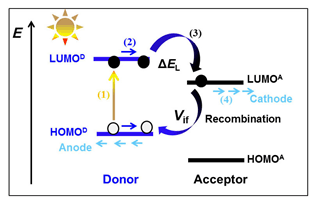| [1] Sariciftci, N. S.; Smilowitz, L.; Heeger, A. J.; Wudl, F. Science 1992, 258, 1474.
[2] Anthony, J. E.; Facchetti, A.; Heeney, M.; Marder, S. R.; Zhan, X. Adv. Mater. 2010, 22, 3876.
[3] Meng, Q. B. Acta Chim. Sinica 2015, 73, 161. (孟庆波, 化学学报, 2015, 73, 161.)
[4] Carlotto, S. J. Phys. Chem. A 2014, 118, 4808.
[5] Armin, A.; Kassal, I.; Shaw, P. E.; Hambsch, M.; Stolterfoht, M.; Lyons, D. M.; Li, J.; Shi, Z.; Burn, P. L.; Meredith, P. J. Am. Chem. Soc. 2014, 136, 11465.
[6] Mishra, A.; Bäuerle, P. Angew. Chem. Int. Ed. 2012, 51, 2020.
[7] Walker, B.; Liu, J.; Kim, C.; Welch, G. C.; Park, J. K.; Lin, J.; Zalar, P.; Proctor, C. M.; Seo, J. H.; Bazan, G. C.; Nguyen, T.-Q. Energy Environ. Sci. 2013, 6, 952.
[8] Wang, Z.; Uemura, Y.; Zhou, Y.; Miyadera, T.; Azumi, R.; Yoshida, Y.; Chikamatsu, M. ACS Appl. Mater. Interfaces 2015, 7, 10814.
[9] Heremans, P.; Cheyns, D.; Rand, B. P. Acc. Chem. Res. 2009, 42, 1740.
[10] Reese, M. O.; Nardes, A. M.; Rupert, B. L.; Larsen, R. E.; Olson, D. C.; Lloyd, M. T.; Shaheen, S. E.; Ginley, D. S.; Rumbles, G.; Kopidakis, N. Adv. Funct. Mater. 2010, 20, 3476.
[11] Fu, Y.; Wang, F.; Zhang, Y.; Fang, X.; Lai, W.; Huang, W. Acta Chim. Sinica 2014, 72, 158. (付钰, 王芳, 张燕, 方旭, 赖文勇, 黄维, 化学学报, 2014, 72, 158.)
[12] Dou, C.; Chen, D.; Iqbal, J.; Yuan, Y.; Zhang, H.; Wang, Y. Langmuir 2011, 27, 6323.
[13] Woo, C. H.; Holcombe, T. W.; Unruh, D. A.; Sellinger, A. Chem. Mater. 2010, 22, 1673.
[14] Wolfer, P.; Schwenn, P. E.; Pandey, A. K.; Fang, Y.; Stingelin, N.; Burn, P. L.; Meredith, P. J. Mater. Chem. A. 2013, 1, 5989.
[15] Bloking, J. T.; Han, X.; Higgs, A. T.; Kastrop, J. P.; Pandey, L.; Norton, J. E.; Risko, C.; Chen, C. E.; Bredas, J.-E.; McGehee, M. D.; Sellinger, A. Chem. Mater. 2011, 23, 5484.
[16] Barone, V.; Cossi, M. J. Phys. Chem. A 1998, 102, 1995.
[17] Schlenker, C. W.; Thompson, M. E. Chem. Commun. 2011, 47, 3702.
[18] Newton, M. D.; Sutin, N. Ann. Rev. Phys. Chem. 1984, 35, 437.
[19] Barbara, P. F.; Meyer, T. J.; Ratner, M. A. J. Phys. Chem. 1996, 100, 13148.
[20] Lemaur, V.; Steel, M.; Beljonne, D.; Brédas, J.-L.; Cornil, J. J. Am. Chem. Soc. 2005, 127, 6077.
[21] Hsu, C. P. Acc. Chem. Res. 2009, 42, 509.
[22] Yang, Y. M.; Yin, S. W.; Li, L. L.; Yang, J. Y. Acta Chim. Sinica 2011, 69, 1991. (杨永梅, 尹世伟, 李兰兰, 杨家瑜, 化学学报, 2011, 69, 1991.)
[23] Grimme, S. WIREs Comput. Mol. Sci. 2011, 1, 211.
[24] Liu, H.; Brémond, É.; Prlj, A.; Gonthier, J. F.; Corminboeuf, C. J. Phys. Chem. Lett. 2014, 5, 2320.
[25] Guan, L.; Wang, W. L.; Shao, R.; Liu, F. Y.; Yin, S. W. J. Mol. Model. 2015, 21, 126-1.
[26] Zhan, X.; Facchetti, A.; Barlow, S.; Marks, T. J.; Ratner, M. A.; Wasielewski, M. R.; Marder, S. R. Adv. Mater. 2011, 23, 268.
[27] Shao, R.; Wang, W. L.; Yang, X. B.; Yin, X. W. Sci. China-Chem. 2016, 46, 699. (邵绒,王文亮, 杨鑫博, 尹世伟, 中国科学: 化学, 2016, 46, 699.)
[28] Liu, X.; Su, S. J.; Cao, Y. Polymer Bulletin 2014, 12, 68. (刘欣, 苏仕健, 曹镛, 高分子通报, 2014, 12, 68.)
[29] Nalwa, H. S. Handbook of Advanced Electronic and Photonic Materials and Device, Academic San Diego, CA, 2001.
[30] Fitzner, R.; Reinold, E.; Mishra, A. Adv. Funct. Mater. 2011, 21, 897.
[31] Lin, L. Y.; Chen, Y. H.; Huang, Z. Y.; Lin, H. W.; Chou, S. H.; Lin, F.; Chen, C. W.; Liu, Y. H.; Wong, K. T. J. Am. Chem. Soc. 2011, 133, 15822. |
